Royal Artillery
| Royal Regiment of Artillery | |
|---|---|
 Cap Badge of the Royal Regiment of Artillery | |
| Active | 1716–present |
| Allegiance |
|
| Branch |
|
| Role | Artillery |
| Size |
13 Regular regiments 5 Reserve regiments |
| Garrison/HQ | Various: Larkhill (Regimental HQ), Catterick, Tidworth, Colchester, Hohne |
| Motto(s) | Ubique Quo Fas Et Gloria Ducunt ("Everywhere That Right And Glory Lead"; in Latin fas implies "sacred duty")[1] |
| Colours | The guns are regarded as the regimental colours and are accorded the same compliments as the Standards, Guidons and Colours of the Cavalry and Infantry |
| March | British Grenadiers / Voice Of The Guns (Quick); The Royal Artillery Slow March colloquially known as The Duchess of Kent (Slow); The Keel Row (Trot); "Bonnie Dundee" (Canter) |
| Commanders | |
| Captain General | HM The Queen Elizabeth II |
| Master Gunner, St James's Park | Lieutenant General Sir Andrew Gregory KBE CB |
| Insignia | |
| Tactical Recognition Flash |
 |
 |
| Arms of the British Army |
|---|
| Combat Arms |
|
|
| Combat Support Arms |
| Combat Services |
|
|
The Royal Regiment of Artillery, commonly referred to as the Royal Artillery (RA) and colloquially known as "The Gunners", is the artillery arm of the British Army. The Royal Regiment of Artillery comprises thirteen Regular Army regiments, King's Troop Royal Horse Artillery and five Army Reserve regiments.[2]
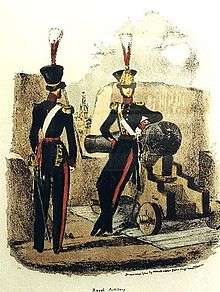
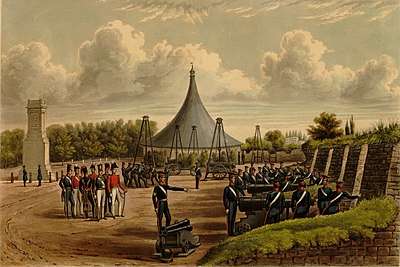


History
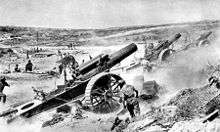
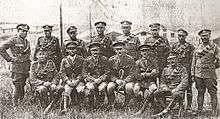
The introduction of artillery into the English army came as early as the Battle of Crécy in 1346.[3] Henry VIII made the army's artillery semi-permanent in the sixteenth century but the recognition of the need for a permanent body of artillery did not happen until 1716.[3]
Before the 18th century, artillery 'traynes' were raised by royal warrant for specific campaigns and disbanded again when they were over.[3] (Personnel for this purpose were drafted in either from the Tower of London, headquarters of the Ordnance Office, or else from the small teams of gunners based at various castles and forts around the country.)[4] On 26 May 1716, however, by royal warrant of George I two regular companies of field artillery, each 100 men strong, were raised at Woolwich.[3] The title "Royal Artillery" (RA) was first used in 1720.[3] On 1 April 1722 the two companies were increased to four and grouped with independent artillery companies at Gibraltar and Menorca to form the Royal Regiment of Artillery, commanded by Colonel Albert Borgard.[3] In 1741 the Royal Military Academy was formed in the Royal Arsenal at Woolwich (RWA) to provide training for RA and Royal Engineers (RE) officers.[3] The regiment expanded rapidly and, by 1757, had 24 companies divided into two battalions, as well as a cadet company formed in 1741.[3] During 1748, the presidential artilleries of Bengal, Madras and Bombay were formed.[3] 1756 saw the creation of the Royal Irish Regiment of Artillery.[3] In 1762 the Royal Artillery Band was formed at Minden. By 1771 there were 32 companies in four battalions, as well as two "invalid companies" comprising older and unfit men employed in garrison duties. During 1782, the regiment moved to the Royal Artillery Barracks (front parade) on Woolwich Common.[3] In January 1793, two troops of Royal Horse Artillery (RHA) were raised to provide fire support for the cavalry, augmented by two more in November 1793.[3] All RHA personnel were mounted. The Royal Irish Artillery was absorbed into the RA in 1801.[3] During 1805, the Royal Military Academy moved to Woolwich Common.[3]
In 1819, the Rotunda was given to the regiment by the Prince Regent to celebrate end of the Napoleonic Wars. (It was originally built in St. James's Park as the outer casing of the tent in which the Prince Regent entertained the Allied sovereigns in 1814.[5]) In 1832, the regimental motto, Ubique Quo Fas Et Gloria Ducunt ("Everywhere That Right And Glory Lead"; in Latin fas implies "sacred duty"), was granted.[1] The motto signified that the regiment had seen action in all the major conflicts of the British Army and almost all of the minor ones as well.[6]
The regiment was under the control of the Board of Ordnance until the board was abolished in 1855. Thereafter the regiment came under the War Office along with the rest of the army.[3] The School of Gunnery established at Shoeburyness, Essex in 1859.[3] In 1862 the regiment absorbed the artillery of the British East India Company—21 horse batteries and 48 field batteries—which brought its strength up to 29 horse batteries, 73 field batteries and 88 heavy batteries.[3]
On 1 July 1899, the Royal Artillery was divided into three groups: the Royal Horse Artillery of 21 batteries and the Royal Field Artillery of 95 batteries composed one group, while the coastal defence, mountain, siege and heavy batteries were split off into another group named the Royal Garrison Artillery of 91 companies.[3] The third group continued to be titled simply Royal Artillery, and was responsible for ammunition storage and supply. Which branch a gunner belonged to was indicated by metal shoulder titles (R.A., R.F.A., R.H.A., or R.G.A.). The RFA and RHA also dressed as mounted men, whereas the RGA dressed like foot soldiers. In 1920 the rank of Bombardier was instituted in the Royal Artillery.[3] The three sections effectively functioned as separate corps. This arrangement lasted until 1924, when the three amalgamated once more to become one regiment.[3] In 1938, RA Brigades were renamed Regiments. During the World War II there were over 1 million men serving in 960 gunner regiments.[7] In 1947 the Riding House Troop RHA was renamed The King's Troop RHA and, in 1951, the title of the regiment's colonel-in-chief became Captain General.[3] When The Queen first visited the Troop after her accession, it was expected that it would become "The Queen's Troop", but Her Majesty announced that in honour of her father's decision it would remain "The King's Troop".[8]
The Royal Horse Artillery, which has separate traditions, uniforms and insignia, still retains a distinct identity within the regiment.[3]
Before World War II, Royal Artillery recruits were required to be at least 5 feet 4 inches (1.63 m) tall. Men in mechanised units had to be at least 5 feet 8 inches (1.73 m) tall. They initially enlisted for six years with the colours and a further six years with the reserve or four years and eight years. They trained at the Royal Artillery Depot in Woolwich.[9]
From its beginnings, the Royal Artillery has been based at Woolwich, in south-east London. In 2003 it was decided to move the headquarters to Larkhill on Salisbury Plain in Wiltshire (the RA's training ground, where the Royal School of Artillery has been based since 1915). The last Royal Artillery troops left Woolwich Barracks in 2007; in 2012, however, the King's Troop, Royal Horse Artillery was relocated to Woolwich from their former headquarters in St John's Wood.[10]
The Royal Artillery today
The Royal Artillery is equipped with a variety of equipment and performs a wide range of roles, including:
- Surveillance and Target Acquisition/Unmanned Air Systems
- Commando and Airborne artillery
- Self Propelled Artillery
- Multiple Launch Rocket Systems
- Air defence
The Captain General of the regiment is Queen Elizabeth II. The post was previously known as Colonel-in-Chief until King George VI expressed the desire to be known as Captain General. The head of the regiment is the Master Gunner, St. James's Park.
The Royal Regiment of Artillery comprises both Regular (full-time) and Reserve (part-time) units. The Royal Regiment of Artillery is unusual in that it has sub-units that often move between regiments, or are placed into suspended animation. See List of Royal Artillery Batteries.
Regular Army
The Royal Regiment of Artillery comprises 13 Regular Army Regiments and are designated by a number and the name Royal Artillery (RA) or Royal Horse Artillery (RHA). Historically these names reflected the role the units performed, but in the modern era are retained purely for historical reasons.
Regular regiments of the Royal Horse Artillery
- The King's Troop, Royal Horse Artillery – a ceremonial unit equipped with 13 pounder guns for firing salutes. Now located in Woolwich Garrison, London.
- 1st Regiment Royal Horse Artillery – equipped with AS90 self-propelled artillery and MLRS at Assaye Barracks in Tidworth. The Regiment will move to Larkhill barracks by 2020.
- 3rd Regiment Royal Horse Artillery – (The Liverpool and Manchester Gunners) are equipped with L118 105mm light gun based at Albemarle Barracks outside Newcastle-Upon-Tyne.
- 7th Parachute Regiment Royal Horse Artillery – (The Airborne Gunners) are equipped with L118 105mm light gun and are currently part of 16th Air Assault Brigade based in Colchester.
Regular regiments of the Royal Artillery
- 4th Regiment Royal Artillery – (The North East Gunners) are equipped with L118 105mm light gun at Alanbrooke Barracks in Topcliffe.
- 5th Regiment Royal Artillery – (The North, East & West Yorkshire Gunners) are equipped with Surveillance and Target Acquisition assets and are based at Marne Barracks in Catterick, North Yorkshire. The Regiment will move to Larkhill barracks in 2018/19.
- 12 Regiment Royal Artillery – (The Lancashire and Cumbrian Gunners) are an air defence unit equipped with Starstreak HVM and are based at Baker Barracks, Thorney Island.
- 14 Regiment Royal Artillery – are the Training and Support Regiment based at Stirling Barracks in Larkhill.
- 16 Regiment Royal Artillery – (The London and Kent Gunners) are an air defence unit equipped with Rapier and are based at Baker Barracks, Thorney Island.
- 19 Regiment Royal Artillery – (The Highland Gunners) are equipped with AS90 self-propelled artillery and MLRS at Assaye Barracks in Tidworth. They are expected to move to Larkhill Barracks by 2020.
- 26 Regiment Royal Artillery –– (The West Midland Gunners) are equipped with AS90 self-propelled artillery and MLRS at Mansergh Barracks, Guttersloh, Germany. They are expected to move to Larkhill barracks as a dedicated MLRS Regiment by 2021.
- 29 Commando Regiment Royal Artillery – (The Commando Gunners) are equipped with the L118 105mm light gun, and are currently part of 3 Commando Brigade. Most batteries are currently based at the Royal Citadel in Plymouth, with one battery (148 (Meiktila) Battery) based at RM Poole and 7 (Sphinx) Battery based at Royal Marines Base Condor in Arbroath.
- 32 Regiment Royal Artillery – (The Wessex Gunners) are equipped with Unmanned Air Vehicles and are based in Roberts Barracks in Larkhill. The regiment will disband with personnel redistributed to other parts of the British Army in 2021.[11]
- 47 Regiment Royal Artillery – (The Hampshire and Sussex Gunners) – are equipped with the Thales Watchkeeper WK450 and are based in Horne Barracks in Larkhill.
Army Reserve
- 101 (Northumbrian) Regiment Royal Artillery (MLRS)
- 103 (Lancashire Artillery Volunteers) Regiment Royal Artillery (Field Artillery) (Lancashire Artillery Volunteers Band)
- 104 Regiment Royal Artillery: Equipped with the L118 light gun[12]
- 105 Regiment Royal Artillery 'The Scottish & Ulster Gunners' are equipped with the L118 light gun.
- 106 (Yeomanry) Regiment Royal Artillery: Air defence.
Equipment
Air defence
The Royal Artillery utilised two different air defence weapons:
- Rapier FSC – Rapier is a Short Range Air Defence weapon (SHORAD) that is operated by 16th Regiment.
- Starstreak HVM – Starstreak HVM is a Very Short Range Air Defence (VSHORAD) system that is a continuation of the Blowpipe and Javelin series. It is operated as either a shoulder-launched weapon, in the Lightweight Multiple Launcher mode or mounted on the Alvis Stormer armoured vehicle. The weapon is operated by 12th Regiment and 106 Regiment RA.
Close support artillery
The Royal Artillery field the following Close Support/Offensive Support weapons:
- MLRS – the Multiple Launch Rocket System provides a precision fire capability out to a range of 85 km. In 2014 the dedicated 39th Regiment RA was disbanded and today the system is integrated into 1st Regiment RHA, 19th Regiment RA and 26th Regiment RA. In the future 26th Regiment will take on a dedicated precision fires role and the system will be withdrawn from 19th Regiment RA and 1st Regiment RHA.
- AS-90 – the AS-90 is a 155mm self-propelled gun and is utilised by 1st Regiment RHA, 19th Regiment RA and 26th Regiment RA.
- L118 light gun – the Light Gun is a 105 mm gun. It is operated by 3rd Regiment RHA, 4th Regiment RA, 7th (Para) Regiment RHA, 29 (Commando) Regt RA, as well as three Army Reserve regiments – 103 Regt RA, 104 Regt RA and 105 Regt RA.
- Exactor (Spike NLOS) – a vehicle-mounted high-precision guided missile. It is currently operated by 1st RHA, 19 RA and 26 RA, with the capability passing solely to 26 RA by 2020.[13]
Intelligence, surveillance, target acquisition and reconnaissance (ISTAR)
- MAMBA (Mobile Artillery Monitoring Battlefield Array) uses radar to track enemy mortar and artillery shells out to a range of 40 km. It can be used to predict the point of impact, thereby giving a number of seconds warning, but is usually deployed to trace the point of origin of mortar/artillery rounds and then provide correction for counter-battery fire. It is operated by 5th Regiment RA.
- ASP (Advanced Sound-ranging Program) is an acoustic triangulation system that used a series of sensor posts (microphones) to triangulate the point of origin and point of impact of enemy mortars and artillery. It is also operated by 5th Regiment RA along with 101st (Northumbrian) Regiment Royal Artillery.
- BASE ISTAR - 5th Regiment RA also operates a number of telescopic camera systems that are designed to provide surveillance and target acquisition in static locations.
- Thales Watchkeeper WK450 (UAV) is operated by 47th Regiment Royal Artillery.
- Desert Hawk III UAV – the DH3 is a hand-launched UAV. It is operated by 32nd Regiment and will be withdrawn from service from 2021.
Ceremonial
- 13 pounder – The King's Troop, Royal Horse Artillery retains six operational First World War-era QF 13 pounders for use as state saluting guns
Order of precedence
| Preceded by Royal Armoured Corps |
Order of Precedence | Succeeded by Corps of Royal Engineers |
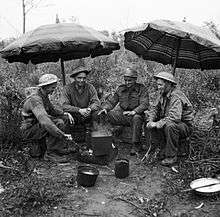
In the British Army Order of Precedence, the Household Cavalry is always listed first and always parades at the extreme right of the line. However, when the Royal Horse Artillery is on parade with its guns, (usually in the form of The Kings Troop, Royal Horse Artillery) it will replace the Household Cavalry at the extreme right of the line.[14]
Museum
The Regimental museum, "Firepower" located in the Royal Arsenal at Woolwich closed in 2017. It is expected to relocate to Larkhill.
Affiliations









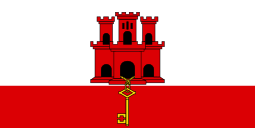

See also
- List of Royal Artillery Batteries
- Artillery
- Royal Artillery Mounted Band
- Royal Artillery Band
- Royal Artillery Memorial
- Royal Artillery Barracks
- Royal School of Artillery
- Firepower – The Royal Artillery Museum
- Bermuda Militia Artillery
- Royal Regiment of Canadian Artillery
- Royal Regiment of Australian Artillery
- Royal Regiment of New Zealand Artillery
- 79th Light Anti-Aircraft Battery
- Manx Regiment
- List of vehicles used by the British Army
References
- 1 2 "No. 18952". The London Gazette. 10 July 1832. p. 1583.
- ↑ cgsmediacomma-amc-dig-shared@mod.uk, The British Army,. "The British Army - Regiments". www.army.mod.uk. Retrieved 2017-03-03.
- 1 2 3 4 5 6 7 8 9 10 11 12 13 14 15 16 17 18 19 20 21 22 History and Traditions of the Royal Artillery
- ↑ Hogg, Brigadier O.F.G. (1963). The Royal Arsenal. Oxford University Press. pp. 302–344.
- ↑ Woolwich Common in Garden and Landscape Guide
- ↑ Anon (1916) Regimental Nicknames and Traditions of the British Army. 5th Ed. London: Gale and Polden Ltd. p. 36
- ↑ Royal Artillery History
- ↑ "King's Troop: A modern history of 1945 to 2012". Ham & High. Retrieved 13 October 2015.
- ↑ War Office, His Majesty's Army, 1938
- ↑ King's Troop moves to its 'spiritual home' in Woolwich at BBC News, 7 February 2012. Accessed 8 February 2012
- ↑ "Strategic Defence and Security Review - Army:Written statement - HCWS367 - UK Parliament". Parliament.uk. 2014-12-04. Retrieved 2016-12-16.
- ↑ "Letter from Brigadier Mead". 1st Artillery Brigade and Headquarters South West. Retrieved 16 December 2016.
- ↑ "In Search of Exactor". Think Defence. 7 April 2014. Retrieved 23 January 2016.
- ↑ Royal horses get their sea legs with a dip in the surf on Cornwall holiday Daily Mail, 21 September 2011
Further reading
- Graham, C A L (1939). The Story of the Royal Regiment of Artillery. RA Institution, Woolwich.
External links
| Wikimedia Commons has media related to Royal Artillery. |